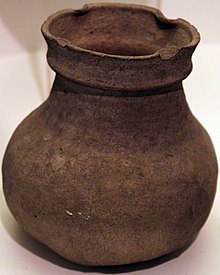Earthenware
| Ceramics | Class: Earthenware |
|
Earthenware (also earthenware ) is a collective term for a class of ceramic , “earthen” (from Middle High German irdīn “earthen”) materials fired at low temperatures . With them, the shards do not sinter completely tightly during the firing process, so that unglazed earthenware is water-permeable due to its open porosity. Earthenware includes so-called pottery (with firing temperatures of around 700 - 800 ° C), faience and other pottery (with firing temperatures between 950 ° C and 1040 ° C), and earthenware (with firing temperatures mostly between 1120 ° C and 1250 ° C ).
The most important raw materials are clay , feldspar , lime and in some cases other additives. The sintered body is porous, hard, firm and also thinly structured and not translucent.
Individual evidence
- ^ Hermann Salmang, Horst Scholze, Rainer Telle (ed.): Ceramics. 7th edition, Heidelberg 2007, p. 699.
